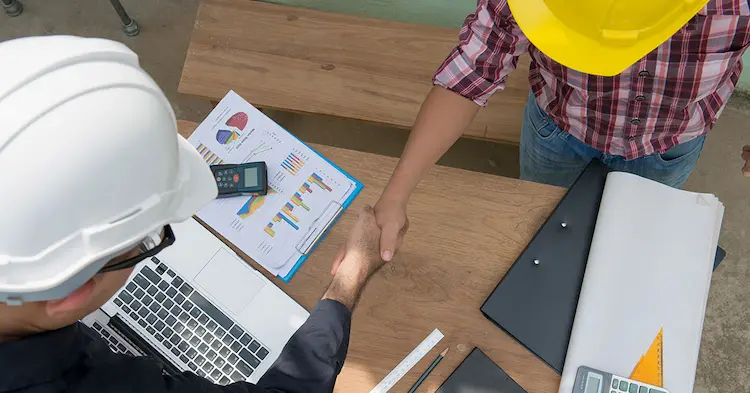Ladies and gentlemen, put on your hard hats and safety goggles because we’re about to dive headfirst into the world of construction tenders. Now, I know what you’re thinking: “Construction tenders? Is this a blog post or a cure for insomnia?”
But trust me, understanding the ins and outs of tenders is crucial if you want to succeed in the construction industry. Plus, you might just pick up a few entertaining tidbits along the way.
Keep reading this article till the end to learn more about the tenders in the construction industry.

The Role of Tenders in the Construction Industry
Picture this: You’re a construction company, and you’re looking to land that next big project. Maybe it’s building a luxury high-rise, or perhaps it’s constructing a state-of-the-art sports arena. How do you get your foot in the door? Enter the tendering process that can be achieved when you access construction tenders with Tracker.
A tender is like a golden ticket. It’s an invitation to submit a proposal and compete against other companies for the chance to win a contract. Let’s get into the little details of what a tender is and how to have the best tender bidding.
What is a Tender?
A tender is a request for bids on a project or an official invitation to accept an offer, like a takeover bid. This phrase typically describes the method via which the federal government and financial entities submit invitation bids for major projects. There is a deadline for submitting these bids.
In other words, a tender is essentially a proposal to give the customer goods and services tailored to their needs. It is an open invitation to all shareholders to offer their shares for sale at a set price and during a certain window of time.
Smaller investors purchase government securities using a non-competitive tender procedure, whereas large institutional investors purchase government securities via a competitive tender process.
Let’s take a look at it in a much more detailed manner!
Types of Tenders
Now that you know why tenders are vital, let’s talk about the different types: open tenders, where any company can submit a proposal, and restricted tenders, where only pre-selected companies can participate. Then there are two-envelope tenders, which involve submitting both a technical proposal and a financial proposal, and single-stage tenders, where you submit everything at once.
Also Read: Improving Labor Productivity in Your Construction Business
The Tendering Process: A Step-by-Step Guide
The solicitation of bids, the submission of your bids, the procedure of decision-making, and the creation of the contract are typical processes in the tender process. The contractor begins the project and sees it through to completion once each of these processes has been completed.
Ready to throw your hat in the ring? Here’s a breakdown of the tendering process:
- Notice: Keep an eye out for tender notices, which are usually published in newspapers or online portals.
- Preparation: Once you’ve found a tender that interests you, it’s time to put together your proposal. This involves researching the project requirements and crunching numbers.
- Submission: Submit your proposal by the deadline to ensure you are not penalized.
- Evaluation: The client will review all the submitted proposals, comparing them based on factors like cost, experience, and technical expertise.
- Award: If your proposal is chosen, congratulations! If not, that’s okay, be sure to ask for any feedback on your proposal to ensure you win the next one.
Tips for Submitting a Successful Tender

Here are some pointers for creating an effective tender that will make you stand out from the competition and improve your chances of being selected:
- Do your homework: Researching the project requirements thoroughly pays off, and make sure your proposal addresses all that should be addressed.
- Be clear and concise: Your proposal should be easy to understand and free of jargon, and the reasoning behind this is to remember you’re trying to impress the client, not confuse them.
- Showcase your experience: Highlight your company’s past successes and expertise in similar projects.
- Offer competitive pricing: While you don’t want to undersell yourself, offering a competitive price can help you edge out the competition.
- Proofread: Nothing says “unprofessional”, like a proposal riddled with typos and grammatical errors. Take the time to proofread your work.
How is A Tender Different From RFT?
Now that you know what a tender is, it is important that you learn the basic difference between a tender and an RFT.
A formal request or invitation to suppliers to submit competitive bids for the delivery of goods, services, and raw materials is known as a request for tender, or RFT. In the private sector, the request for proposals, or RFP, is most frequently used to refer to the request for tenders or RFT. These requests enable potential bidders to react to the issuer’s needs.
On the other hand, an offer to provide the consumer with goods and services that are specifically suited to their needs is essentially a tender.
RFT is the document or documents that the buyer makes public in order to get answers from suppliers. Typically, an RFT will include the following documents:
- Tender Condition: guidelines for the tendering process and how to respond
- Form of Tender: timetables and subtleties Providers need to remember for their reaction
- Scope of Tender: details about the goods or services that the Buyer needs
- Criteria of Evaluation: particulars regarding how the Buyer will evaluate responses
- Conditions of the Contract: details of the legal contract that will be given to the winning Supplier
Conclusion
In conclusion, while construction tenders might not be the most glamorous part of the industry, they play a crucial role in landing projects and growing your business by understanding the types of tenders, mastering the tendering process, and following our tips for success, you’ll be well on your way to nailing your next construction bid.